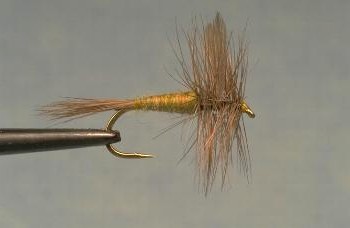On The Fly
"Fly tying is a school from which we never graduate"
 TYING NEWS
TYING NEWS
About 15 members participated in fly tying demonstrations
and craft displays at the RFF January meeting. Everyone on both sides of
the table had a great time tying flies and telling lies. The evening ended
with a very interesting blindfolded tying contest. Don Joslyn accidentally
came up with a new pattern with a fly appendage never tried before and Dick
Bonamarte tried to dazzle the judges with his pink verion of a black leech.
There was a good turnout for the Southern Oregon Fly Tyers'
club meeting Wednesday January 28th, but a shaky start when Morris' key
wouldn't work at the Lions Center. Martha Koch saved the evening by
volunteering use of the craft room at the RV Manor. Thanks again Martha!
Mr. Bonamarte demonstrated woven body techniques on some very realistic
stonefly patterns. Johnny Hale won the fly raffle for the first time and
each of us came away with something new. The next meeting will be held
Wednesday, February 25th, 7 to 9 pm at the Lions Center, keys permitting.
The RFF sponsored beginners and intermediate tying classes
started February 4th and will continue through March on each Wednesday
evening (except for the third Wednesday of the month).
The annual Northwest Fly Tying Expo will be held again this
year at the Eugene Fairgrounds. Over 150 of the most talented tiers will
gather in one place, for one day, to make this event one of the successful
in the country. Mark your calendar for Saturday, March 20th. If you haven't
attended, it's a must see and definitely worth the trip.
 PATTERN OF THE MONTH -
PATTERN OF THE MONTH -
Blue Wing Olive
Hook: Mustad 94840 size 16 - 24
Thread: Olive 6-0
Tail: A small bunch of medium blue dun hackle fibers.
Body: Pale olive rabbit fur dubbing, dressed thin.
Wing: A pair of medium-dun hen hackle tips.
Hackle: Medium blue dun color hackle.
This traditional dubbed-body version has somewhat
oversized wings and long tails cocked slightly upward. It doesn't exactly
match the published proportion charts but it does match the bug itself.
Note that the tying technique for the Adams is identical to that of the
BWO. The key techniques are the placement and construction of the upright
and divided hackle tips and the proper placement of hackle behind and in
front of the wings.
In the RFF January newsletter, Otis Swisher wrote an
article about "Dry Flies in Winter." This month's pattern, the Blue Wing
Olive (BWO), is a very effective and popular Baetis imitation and a useful
winter pattern. There are several mayflies you could call a BWO in just
about every western tailwater, spring creek and freestone stream. The BWO
pattern has been indiscriminately applied to over twenty mayfly species and
has caused much confusion. Most fishermen don't care about the Latin names
and are just happy when one pattern works on so many different hatches.
The "Trout Bum," Dave Roberts, tells me the BWO hatch
should start up again at the Holy Water this month. They will start off
small, size 22 at first, and get larger as the weather warms up into
spring. Dave's favorite imitation is the quill-body version with a
split-fibers tail and dark dun hackle. Other popular styles include the
thorax, no hackle, parachute, and Quigley's cripple. Dave's tying tip is to
cut the bottom of the hackle in a "V" shape, which allows only a few hackle
tips to touch the water for keeping the fly upright.
TYING TIPS - Neat Heads
For small, smooth, strong, nice-looking heads on your
flies, always whip finish with your wraps progressing from the fly body
towards the hook eye. When you wrap the thread towards the eye, the first
thread wrap to be pulled tight is the one closest to the eye, with
subsequent wraps pulled tight as they progress back. The result is a
smooth, nicely tapered head with the thread end well protected by each
individual wrap.
Tie One On,
Dan Kellogg (you can contact me at FLYGUY@EZNORTHWEST.COM)